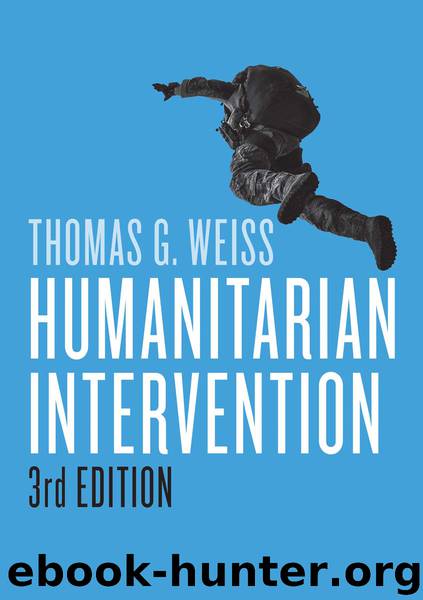Humanitarian Intervention by Weiss Thomas G.;

Author:Weiss, Thomas G.;
Language: eng
Format: epub
Publisher: Polity Press
Published: 2016-03-20T00:00:00+00:00
Measuring the costs and benefits of military humanitarianism
Throughout these pages, readers have encountered an enormous variety of views about the pluses and minuses of using outside military force to protect human beings who are caught in the crosshairs of armed conflicts. Moreover, there has been anything but consistency in the views of participants over time. The ICRC, for instance, as the custodian of the laws of war (also called “international humanitarian law”), has traditionally kept its distance from soldiers. However, in the chaos of Somalia it experimented with hiring “technicals” – local armed guards who mounted automatic weapons on jeeps and were often associated with a particular faction. Its president during the tumultuous 1990s, Cornelio Sommaruga, was a member of ICISS and insisted that his fellow commissioners set aside the expression “humanitarian intervention,” even if he supported the notion of “military intervention for human protection purposes” (the expression finally adopted in the report). Prize-winning journalist David Rieff was an enthusiastic proponent of armed intervention in the Balkans and Rwanda, but by the end of the decade he did an about-face. Disillusioned with what he found in war zones, he proposed returning to the “good old days” of neutral and impartial aid without the use of military humanitarianism.
Two kinds of criticism are worth discussing because they illustrate the problems surrounding a decision about whether the use of military force in a particular humanitarian crisis is justified. The first relates to the ability of a coalition, with or without UN authorization, to stay the course and provide the chance for a country to recover somewhat and even stabilize after a humanitarian intervention. The most tragic recent example is post-intervention Libya, where virtually no international sustenance followed the massive air war and eventual regime change. The unwillingness not only to provide security with boots on the ground but even the most basic assistance reflects the “model” of the precipitous departure of the United States from Somalia after the degrading deaths of 18 Rangers in October 1993. More than two decades later, the country is still fragmented and embroiled in conflict. Even the country’s capital lacks a central governmental authority, as Mogadishu remains a battlefield with AU troops vying to wrestle control of the city from Al Shabab, Islamist rebels linked to Al Qaeda. Somalia’s anarchy has spread to the surrounding high seas, as pirates pose a threat to international shipping through violence and hostage-taking.71
Despite a US-led intervention in 1994, Haiti to this day is also an impoverished and conflict-ridden country with gross human rights violations. The inadequacy of institution building – that is, the creation of a viable governmental apparatus and judicial system to enforce the rule of law – set the country up for renewed violence and rendered it utterly unprepared to cope with the massive earthquake of January 2010, which resulted in anywhere between 46,000 and 85,000 deaths and about 900,000 displaced persons, according to the US Agency for International Development (USAID);72 and the country remains feeble despite publicity and help from former US presidents Bill Clinton and George W.
Download
This site does not store any files on its server. We only index and link to content provided by other sites. Please contact the content providers to delete copyright contents if any and email us, we'll remove relevant links or contents immediately.
The Rule of Law by Bingham Tom(1318)
The Holocaust: A New History by Laurence Rees(1235)
Political Theology by Carl Schmitt(1188)
The Social Animal by David Brooks(1120)
Restitution by Restitution(1115)
Pirates of Somalia by Jay Bahadur(1115)
A Practical Guide to International Arbitration in London by Hilary Heilbron(1084)
Coercing Virtue by Robert H. Bork(1027)
The Nuremberg Interviews by Leon Goldensohn(989)
Basic International Corporate Taxation by Sebastiano Garufi(928)
A History Of Thailand by Baker Chris(890)
Asian Waters by Humphrey Hawksley(878)
International Trade and Business: Law, Policy and Ethics by Gabriël Moens & Peter Gillies(870)
Blood Profits by Vanessa Neumann(868)
Spring Fever: The Illusion of Islamic Democracy by McCarthy Andrew C(867)
The Global Commons by Susan J. Buck(863)
Crimes Against Humanity: Historical Evolution and Contemporary Application by M. Cherif Bassiouni(794)
The Sovereignty of Human Rights by Macklem Patrick(793)
The Nuremberg Trials: The Nazis and their Crimes Against Humanity by Roland Paul(790)
